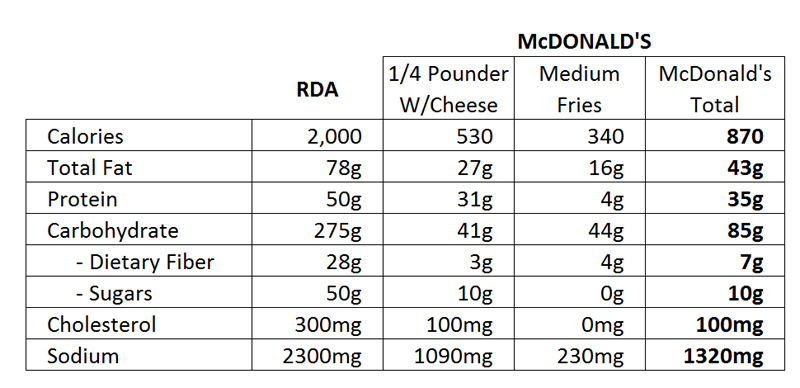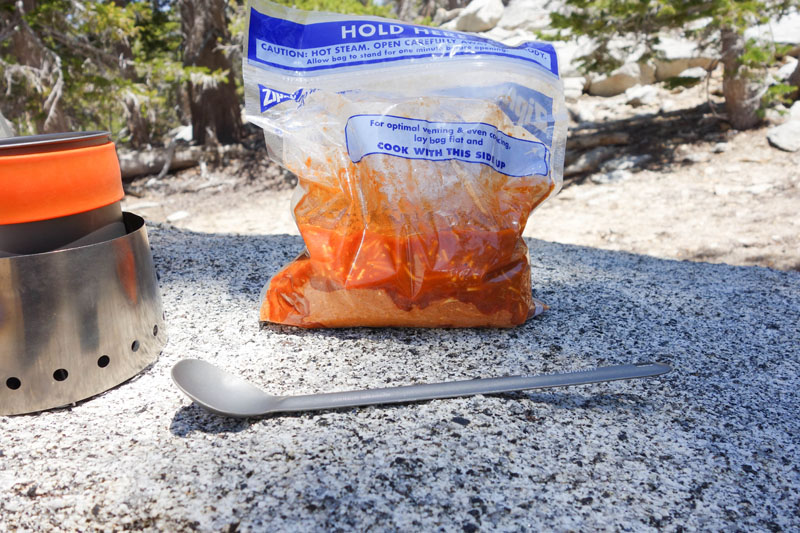
I like Mountain House freeze-dried meals. I bet there are few people who have eaten as many of them as me, since they have been one of my backpacking staples for over 40 years.
Many people tell me they are bad for a person’s health and these same people doubt they taste good. Of course, these are opinions and more than likely are not based on any personal research or knowledge. So what is the verdict?
Disclaimer: I am not a nutritional expert. I know nothing about proper diets, metabolism, or anything related to food and exercise. But — I have led an active lifestyle for decades, without the aid of science or the government in the selection of my food, and using good old common sense have been extremely healthy and never overweight. But if you do what I do and get sick or die, I will not accept any liability for your demise.
Recommended Daily Allowance (RDA)
Our federal government spends millions of dollars to tell us what we should eat. The US Department of Agriculture publishes all kinds of data, reports, and books; more stuff than most of us would ever have time to read. Below is a chart for calories
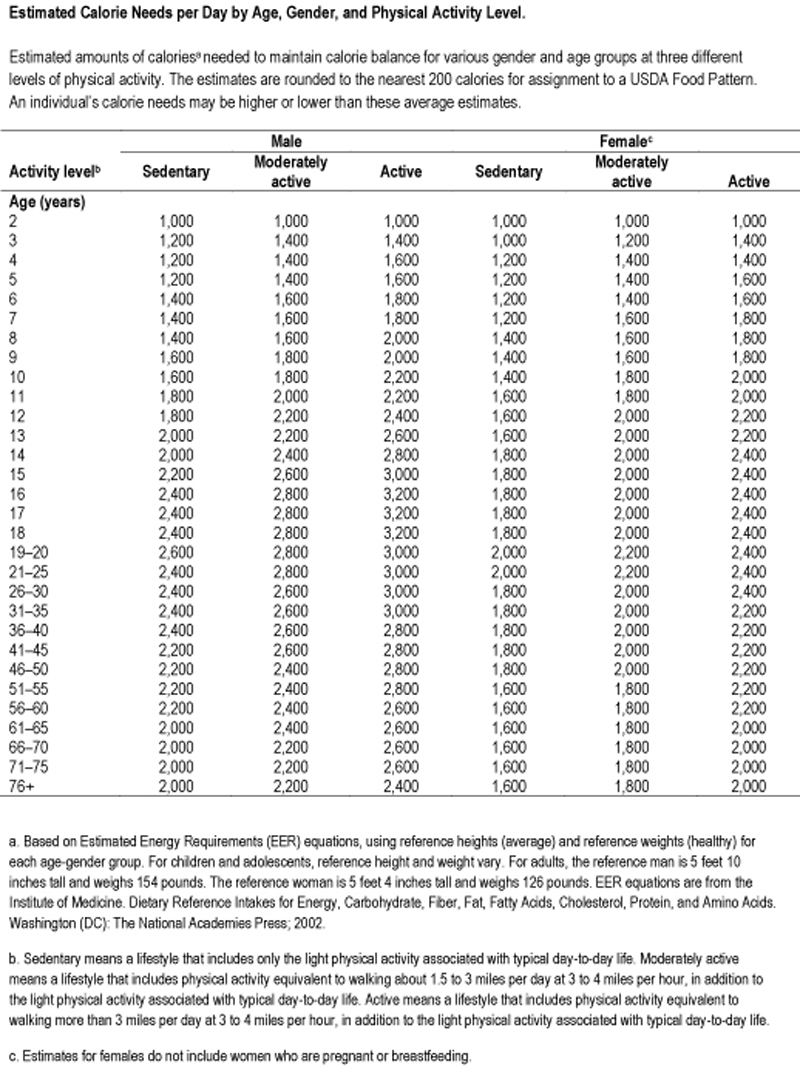 Click here if you want to open a PDF file of the chart.
Click here if you want to open a PDF file of the chart.
You have probably seen the common number of 2,000 calories a day (RDA) for the average adult. Of course that is for a fat-assed adult who never exercises, drives to work or the store, and spends most of his or her leisure on the couch watching TV or playing on the Internet, which is a growing number of adults given than given that 71% of Americans are overweight or obese; 75% for men, 67% for women!!
Nutritional RDA
This is the fine print our government requires the food companies to print on the packaging. Few people read them or understand them. But since YOU, the reader of this post, must be extremely intelligent, because you have the good sense to read my crazy blog, you won’t need me to explain the data below.
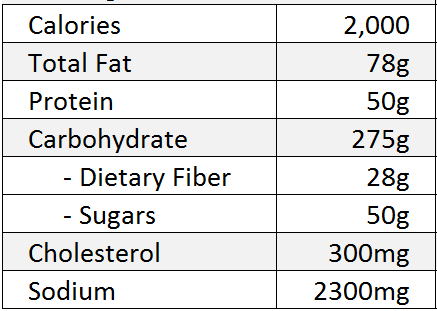
The chart above does us no good because we are backpackers. And if we hike 10-20 miles a day we will burn much more than 2,000 calories. How much more? Hell I don’t know, each of us is different. Each of us burns carbs, fat, and proteins differently. So, for me, on a backpacking trip of less than 7 days I bring about 1.5 LBS of food per day at an average of 125 calories per ounce of food, or 3,000 calories a day. Beyond 6 days my caloric intake demands increase quite a bit.
What are calories?
Aha! Most people don’t know. Calories are a measurement of heat energy. We power our bodies with heat energy. That’s all you need to know unless you are an elite distance runner, marathoner, or ultra-marathoner. If you are just a good ol’ backpacker like me, then don’t spend a lot of time worrying, reading, or discussing calories, fats, carbs, proteins, etc. on social media. Just go backpacking often, and whatever food you crave will balance the percent of carbs, fats, and protein you need — but you should ask your doctor first, to relieve me of any liability in your decision making process. Your body is smarter than your brain.
This, however, is interesting:
- pure fat = 9 calories per gram
- protein = 4 calories per gram
- carbohydrates = 4 calories per gram
So if you are an ultralight backpacker (whatever that is) and you want to carry as many calories as possible with as little weight as possible, then fatty foods would accomplish this.
When backpacking you are going to burn everything you eat and there is really no reason to worry about the ingredients. Now, that we have agreed not to worry about fats, proteins, and carbohydrates there is one other thing to discuss, something that everyone tells us is bad for us — sodium.
Sodium
Salt contains sodium, but salt isn’t sodium. Salt is sodium chloride (NaCl) and is essential to life. Like anything in life, too much of a good thing is bad. When you backpack, especially in deserts, you are going to sweat. If you sweat too much, you will lose too much sodium, and you could die as a result. For backpacking purposes, all we need to know is salty foods are good for us. A great snack during the day is Fritos — high in calories and loaded with salt. Again, disregard what I say and talk to your doctor. But if your doctor is like mine, overweight and sedentary, you might want to take his advice with a “grain of salt.”
How do the Mountain House foods stack up nutrition-wise?
Let’s compare McDonald’s to the RDA for fat Americans. Two very common items, and my favorites, are a Quarter Pounder with Cheese and french fries.
McDonald’s Nutrition Facts
If you aren’t drinking sugary beverages, and even if you are sedentary, this McDonald’s meal isn’t too bad, although the sodium is kinda high. Plus, you can’t take it backpacking. However, they are good foods if you are driving your car, because you can eat them without getting food all over your clothes.
Nutritional Facts for selected Mountain House Dinners (my favorites)
The most popular Mountain House dinners come in foil packaging and contain 2.5 servings per package. Why 2.5 servings? I have no idea. For backpacking you will starve if you just eat a “single serving” of Mountain House. I eat the whole package as a single meal. In the chart below I have included the total nutritional data for the entire Mountain House Meal.
Every one of these meals has fewer calories than a Quarter Pounder with cheese and a medium order of those wonderful tasting french fries. For most of the dinners, the sodium content is a little higher, but that is a good thing when backpacking.
Breakfast Nutritional Information
I love Instant Quaker Oats. It has been my backpacking breakfast mainstay since the 60’s. I’ve tried the Mountain House breakfasts, which are pretty good, but I just prefer two packages of Quaker Oats for breakfast, along with some caffeine (coffee!). I never get bored eating the same thing everyday, because when I was a kid we ate the same things everyday because this is what poor people do.
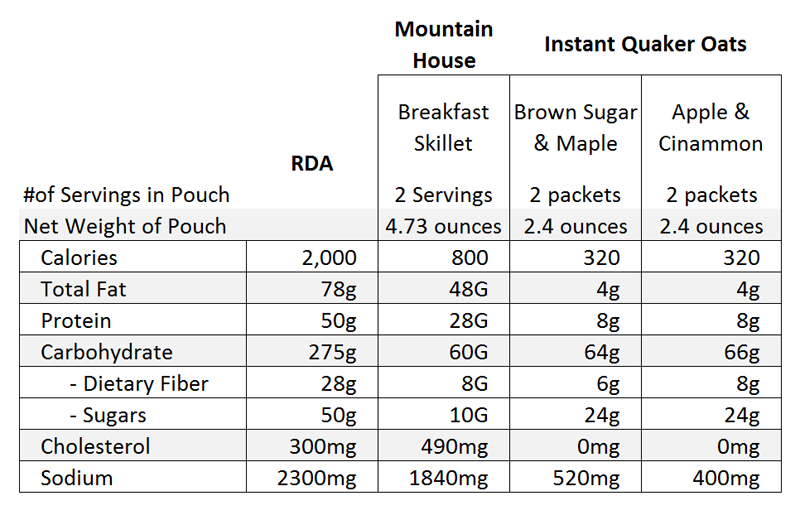 The Mountain House Breakfast Skillet packs quite a few calories and plenty of sodium to get your day going, but since I never eat breakfast at home, I am much happier with the lighter oatmeal option.
The Mountain House Breakfast Skillet packs quite a few calories and plenty of sodium to get your day going, but since I never eat breakfast at home, I am much happier with the lighter oatmeal option.
Keep in mind these Mountain House numbers are for 2.5 servings, and 2 servings for the Breakfast Skillet.
Summary
Keep in mind that the RDA isn’t going to be enough for a long hike, because you will be burning much more energy (calories) than you consume. How much daily nutrition a person needs for let’s say a 2-week backpacking trip varies by individual. You will need to figure out what works for you. But how does a Mountain House dinner meal (2.5 servings) and two packets of Instant Quaker Oats for breakfast stack up versus the RDA?
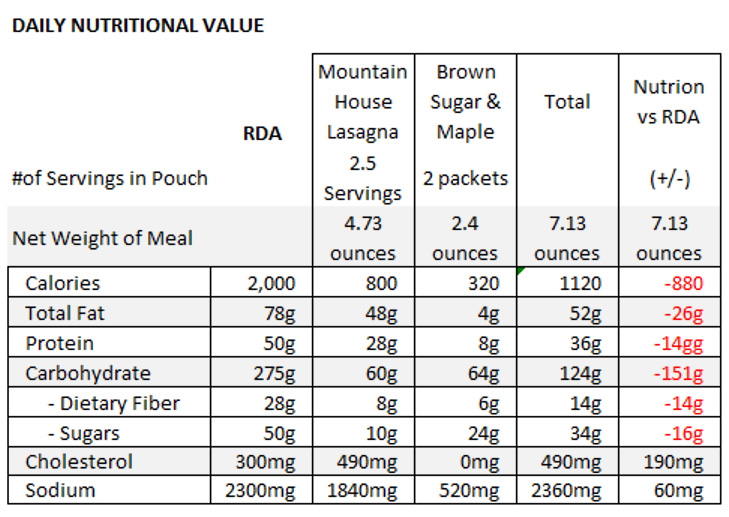
You may be surprised that it is less than the RDA in most categories. Most people have a perception that Mountain House freeze dried meals are full of too much junk. So you will need to supplement (or make up the difference) with foods you eat during the day. Most backpackers don’t stop to have a mid-day lunch, but snack throughout the day. Popular choices (which I consume) are nuts, breakfast bars (think granola bars), candy bars, jerky, potato chips, etc.
What you need to do is determine your daily nutritional needs for each category and create a menu that matches it.
Okay, now that we don’t need to worry about all this nutritional mumbo-jumbo, what should our priorities be?
Low Volume, Low Weight, Convenience, Long Life, Taste
Volume
When backpacking you are carrying your kitchen on your back, and unless you are a masochist, you work hard to minimize the volume of your foods and the weight. The Mountain House meals come in convenient packages that make is easy to simply add boiling water and wait a few minutes before it is ready to eat. This packaging, however, takes up a lot of space.
To reduce the volume, just before each trip, I repackage all my meals into freezer bags, which probably reduces the volume by 67% or more.
 Volume comparison: front left is repackaged Spaghetti with Meat Sauce meal into a freezer bag; front right is two packets of Instant Quaker Oats also in a freezer bag. If you need to store your meals for a long time, keep them in the original packaging.
Volume comparison: front left is repackaged Spaghetti with Meat Sauce meal into a freezer bag; front right is two packets of Instant Quaker Oats also in a freezer bag. If you need to store your meals for a long time, keep them in the original packaging.
You may be thinking, “How are you going to prepare the meals since the original packaging has been discarded?”
Convenience
The freezer bags work just like the original heavy packaging. It’s called freezer bag cooking; I wrote about it several years ago. When I started backpacking years ago, I cooked food in a pot over a fire. Extra time to prepare meals and after every meal cookware to clean, plus, in deserts water is too valuable to use for washing dirty pots. With freezer bag cooking you boil water, add it to the food in the freezer bag, wait a few minutes and you are done. Clean up is easy. Fold up the freezer bag into a small package and pack it out. Clean your spoon with a tiny bit of water. No pots to clean because you only used the pot to boil water, and if you boiled extra water, you could have made coffee, tea, or hot chocolate.
Taste
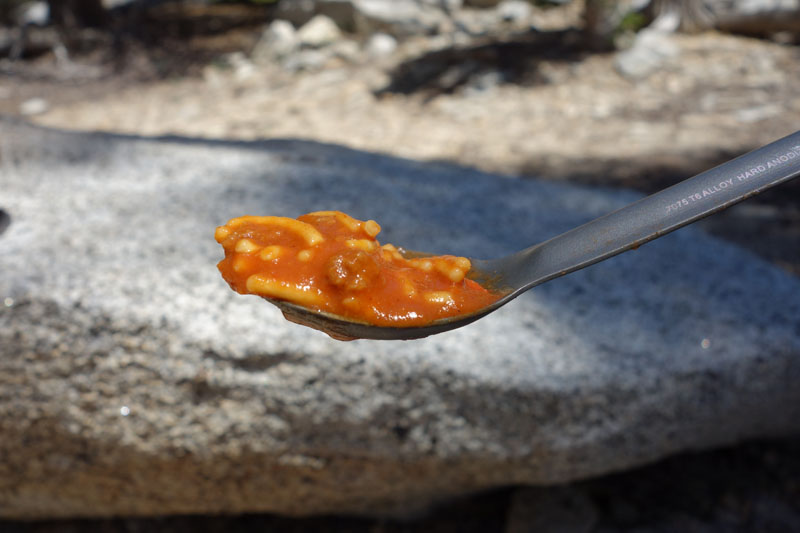
My wife will tell you I am a picky eater. I refuse to try anything new and have a limited menu preference: steak, hamburgers, hot dogs, Mexican food, and Italian food. But I truly like several of the Mountain House offerings.
Long Life
I buy my Mountain House meals in bulk when they are on sale and don’t have to worry about the shelf life, which is 30 years!
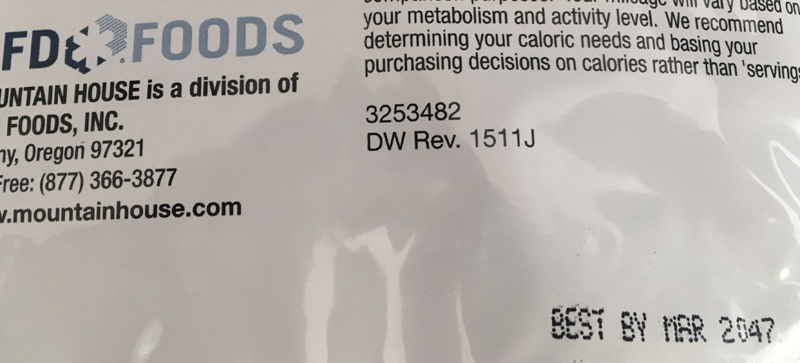
This pouch expires in March of 2047. I will expire before it will because it is unlikely I will live to be 97 years old.
Meals can be purchased in individual packets or in bulk to meet your needs. Be careful when purchasing online as packaging changes. Meals may be 1, 2 or 2.5 serving size.
This website may be compensated for linking to other sites for sales of products. As an Amazon Associate I earn a small fee from qualifying purchases at no additional cost to the purchaser.
If you don’t have a long handle spoon for eating meals out of a pouch, I recommend the Sea to Summit Long Alpha Spoon.
